In the field.
Part II is here.
The desire for invisibility:
The primary task of any street snapping camera (and snapper!) is to become invisible. Literally, the equipment must be an extension of the user’s brain and eye. Historically this rôle was best filled by the Leica M rangefinder with a 35mm lens. Today, that specialty is best filled by small digital cameras fitted with a wide-to-modest-telephoto zoom lens, spanning the classic range afforded by a Leica with wide, standard and 90mm lenses. For the GX7 the optic of choice for the street snapper which best suits the task is the 14-45mm kit lens, equivalent to 28-90mm on full frame. It’s sharp at all apertures, focuses very fast and is silent. The Panny 20mm fails miserably on the last two tasks and is not recommended for street snaps. A modern MFT digital camera with a decent lens will easily deliver far larger and far better printed images than any film era Leica, and with far faster operational utility.
The first ‘roll’:
I snapped some 260 images (7 rolls!) on and around Mission Street in San Francisco the other day and the best news is that there’s little to report, other than that I really liked some of the results. I used Aperture Priority exposure and the RAW file format, as usual. The GX7 mostly nails exposure even in some of the very high contrast lighting scenes encountered. The body handles well and makes for a nicely balance rig with both the 14-45mm kit and 45-200 telephoto zoom Panasonic MFT lenses, both highly recommended. These are not fast optics but the GX7 renders images well even at ISO 1600 (where a touch of noise reduction in LR5 removes grain in really large prints). When a blurred background is called for a quick round-trip through Photoshop and use of the Magic Lasso and the Lens Blur filter does the trick. Color rendering is identical to that in the G1 and G3, which is to say it’s neutral. I used stock settings in the camera with no image filters or like nonsense.
The shutter:
I used the electronic shutter exclusively and the only person who will ever hear the muted susurrous it emits will be the person pressing the button, and that only in a very quiet room. To all intents and purposes the camera is silent, unless you use the ghastly Panasonic 20mm f/1.7 MFT lens with its grinding, bog slow, focus motor which will guarantee your street snaps are out of focus. The GX7’s shutter release features a nice two stage action, the first pressure focusing the lens, the second releasing the shutter and most of the time you will only know the shutter has been released when you see the quick blink in the EVF. For razor sharp responsiveness you can program the camera to take the picture after the first stage of release button pressure, at the risk of being out of focus. Would Cartier-Bresson have killed for this or what? I wrote about how fast, small digital cameras would take over for street snappers over six years ago and except that they have yet to become disposably cheap, that piece was bang on target.
The finder:
There is a slight delay when the camera is raised to the eye before the eye sensor switches on the EVF. In practice this can be mitigated by the simple expedient of lightly touching the shutter release as the camera is being raised to the eye.
The EVF works well, noticeably sharper than in the G1/G3 owing to all those added pixels, and while highlights in the EVF tend to get easily blown out, the effect is less so than in the earlier cameras. EVFs are making rapid progress and I doubt we will see any new cameras coming out with flapping mirrors a decade hence. Couple an EVF with an electronic shutter and you can pretty much have any framing rate desired, untroubled by the mechanical limitations of a flapping mirror and a mechanical shutter.
I did not use the LCD. That’s not a serious image making tool for what I do. The camera itself is unobtrusive, the boxy form factor making it look like any other point-and-shoot, immediately qualifying the user as a tyro. This is a good thing.
The snaps:
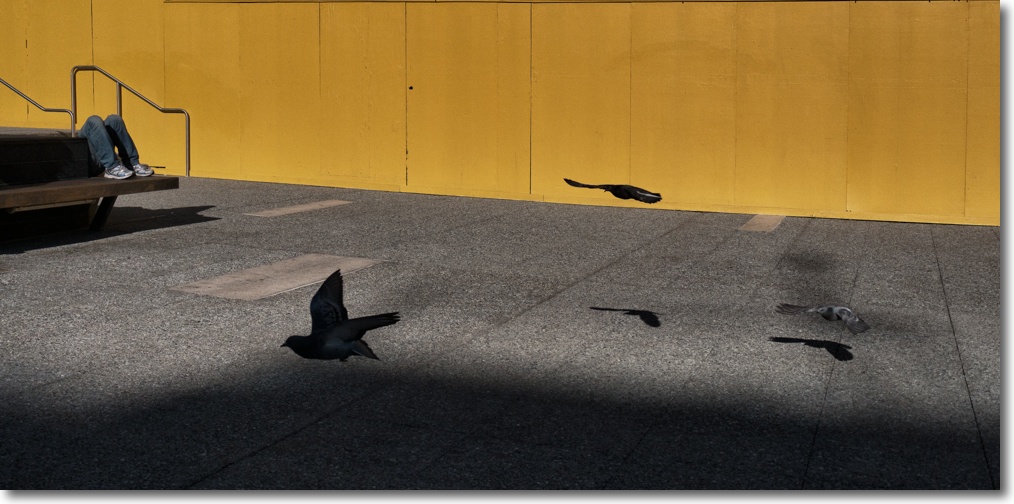
Legs and birds. At the CJM.
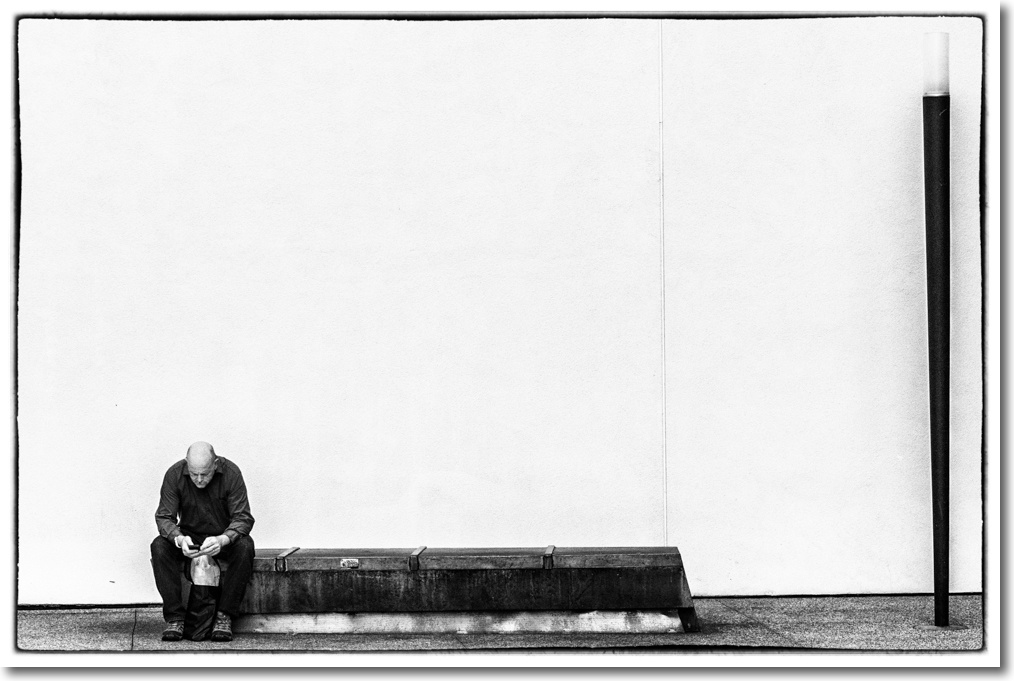
Alone. At the CJM.
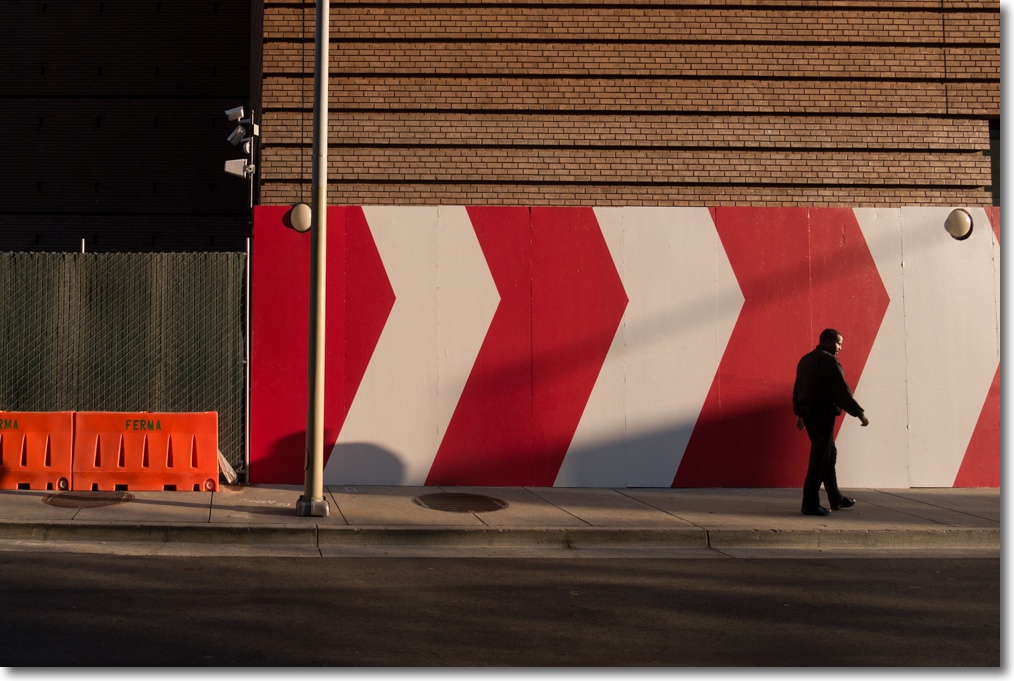
Chevrons. MoMA at Minna Street.
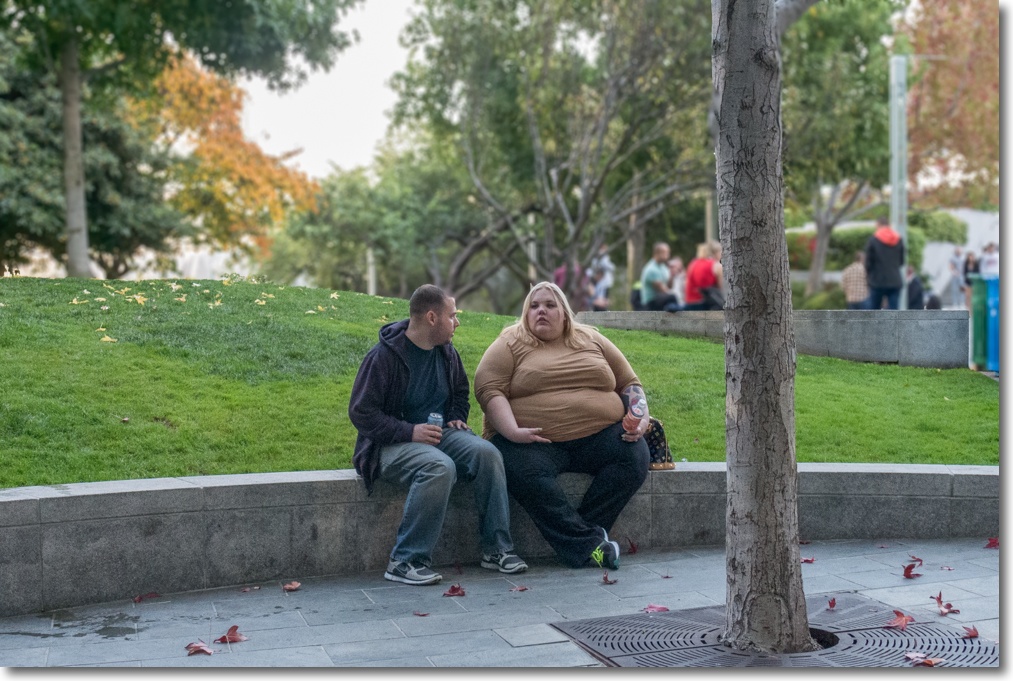
Heavy date. Yerba Buena gardens.
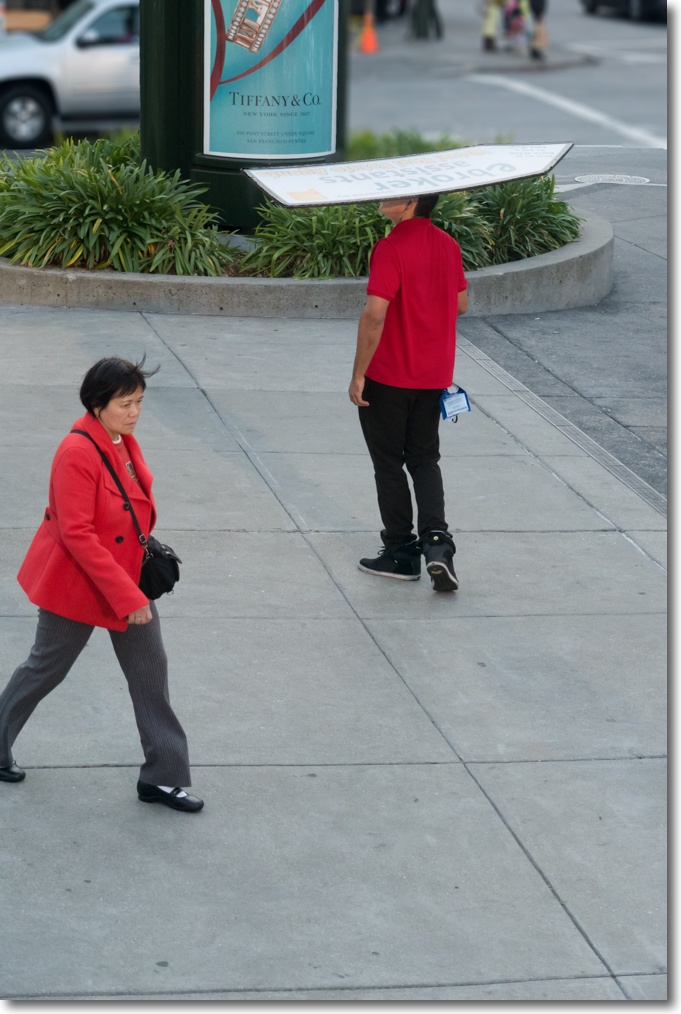
Head bored. At the Mission Street Convention Center.
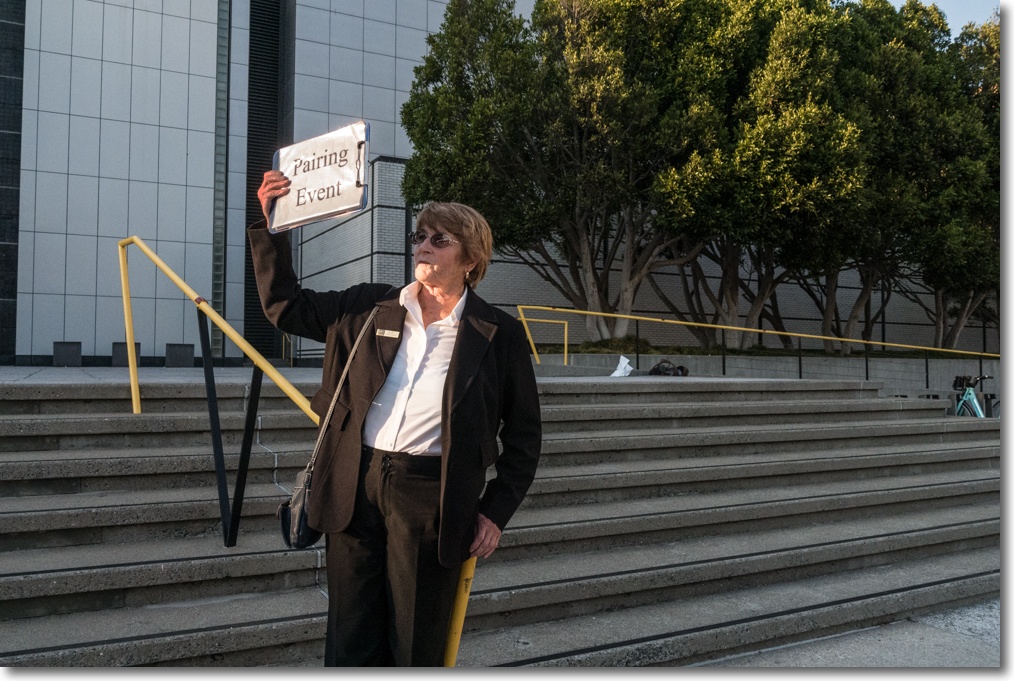
Pairing event. At the Mission Street Convention Center.
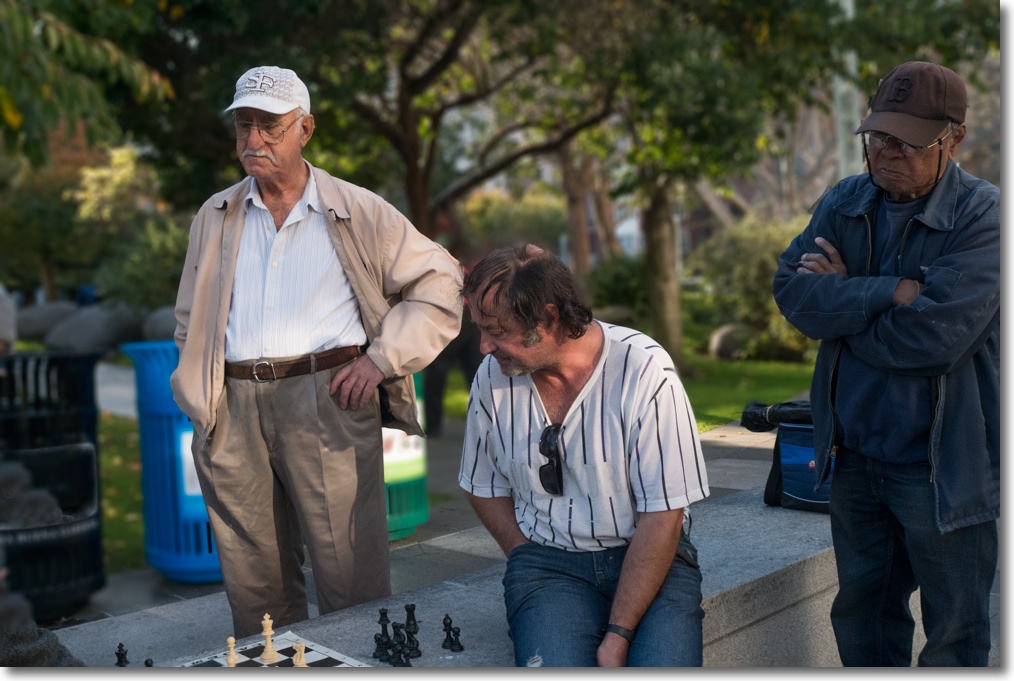
Chess. Yerba Buena gardens.

Waiting. Through the window from inside the Wise Brothers Jewish deli.
I had a pastrami on rye with kosher pickles, natch.
All snapped using the 14-45mm kit lens except the last which was with the 45-200 at full extension. ISO 400-3200 was used – the 6400 limit is unavailable in electronic shutter mode for some reason. By programming the three custom functions on the top right hand mode dial to 400, 1600 and 3200 ISO I could easily switch sensitivity with a click of the knob. The default setting is for the EVF (and LCD, if used) to show a 5 second still of the image after the picture is taken. This is intensely irritating for street snaps when you want to see what’s happening in the finder at all times, and I set the saved custom settings to no image view.
Processing:
RAW images were processed in Lightroom 5.2 with some round-tripped to PS CS5 when background blur was called for. The first two snaps above were round-tripped through Snapseed. At the time of writing, the latest version of iPhoto does not yet recognize GX7 RAW files nor does Apple’s Aperture. I have long questioned Apple’s commitment to still photography apps and this slow update cycle for their key applications seems to confirm my concerns. Aperture in particular, used by many pros, has a history of slow updates, whereas Adobe does an excellent, speedy job with Lightroom and with Adobe Camera RAW for Photoshop.
‘Rolling shutter’ nonsense:
You will see references in the geek press to the ‘rolling shutter’ effect which may be encountered with moving objects when using the electronic shutter in the GX7. For that matter you can get the effect with any mechanical focal plane slit shutter too. It results from the movement of the subject during exposure while the electronics scan (or the slit in the mechanical shutter passes over) the sensor and record the image. It’s an effect which is most famously visible in Jacques-Henri Lartigue’s fabulous race car image snapped in 1913 with a slow-moving focal plane shutter and a rapidly moving car. In street snapping the effect is irrelevant and not noticeable, though Lartigue, it must be said, made the best of it.
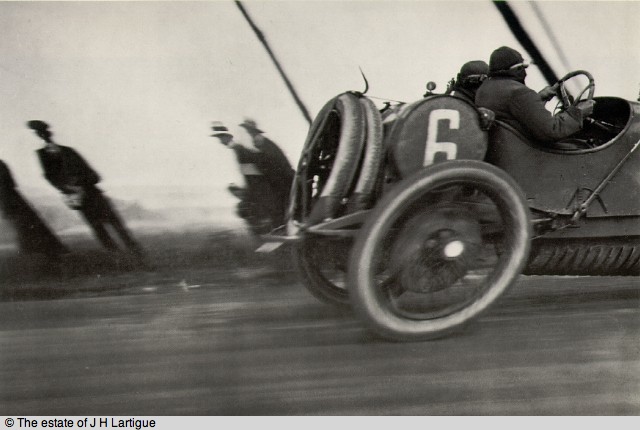
The rolling shutter effect at work. J-HL’s dad at the wheel.
The cull:
I mostly used the maximum aperture available, occasionally stopping down one stop. Of the 260 images, 78 were ‘keepers’. The cull focused on poor composition, lack of drama and so on. In all cases I was to blame, not the GX7. Can’t complain about that or about the 30% retention rate.
Sensor dust in Panny MFT bodies:
As for sensor dust, I have never had as much as one mote with any of the G1 (14,000 images), G3 (5,000 images) or GX7 (260 images), despite changing lenses outdoors with abandon and no precautions taken. Nikon could do worse than learn Panny’s secret here for in my D700, D2x and D3x sensor dirt is very much the order of the day, even in my (sold) D700 which allegedly had a sensor cleaner built-in, though I can’t say I ever noticed the difference.
Ability to tailor the controls and functions:
This has jumped significantly from the G1/G3. There is so much ability to tailor the controls and operation of the GX7 to your liking that I cannot recall ever having encountered something so well thought out. Even my ‘pro’ Nikons are left in the dust in this regard. It makes for a bit more of a learning curve, but a lot of this tailoring is a one-off effort, whereafter the body is set just as you like it. The provision of a large number of programmable function buttons, both hardware and touchscreen, is especially welcome. Commendable.
Recommendation:
The GX7 is unreservedly recommended for the street snapper. Sports and birds-in-flight aficionados will have to look elsewhere for advice as I am clueless about both genres.
It is not cheap, the $900 for the body which I paid having now jumped to $1,000. Panasonic (and Olympus) body pricing seems focused on not being competitive with APS-C bodies, which is a shame as those manufacturers – especially Nikon and Canon – have not made any meaningful technological progress in years, sticking to noisy flapping mirrors and bulky glass pentaprisms. The new Sony FF bodies (A7 and A7R) with EVFs look technically promising, if butt ugly, and it will be a cold day in hell before Sony gets meaningful market share with these. The world is crying out for FF EVF bodies from Canon and Nikon, both of whom seem quite deaf to the demand.
A spare battery for the GX7 is de rigeur, just as soon as Panny makes them available.
If you can lay your hands on a 14-45mm Panasonic kit lens, in preference to the later 14-42mm which is not as good by many accounts, so much the better. Autofocus speed with this lens is instantaneous and the electronics never hunt. That body/lens combination will take you around the world and you will want seldom for other lenses. That’s very much in keeping with the MFT ethos – small and simple. Yes, the zoom collar could be smoother but that’s the only complaint I have. (Well, OK, the provided hood is huge and silly, but you can chuck it out). I recommend you avoid the alternative motor-operated power zoom lenses offered by Panasonic. A manual twist ring room is far faster in every respect, easier to use and drains no precious battery power.
In Part IV I’ll take a look at use with manual focus lenses, an area in which Panny’s design and engineering really excel.
I enjoyed your series on the GX7. I want it, it is affordable, but I don’t really need it right now. I don’t have the 20mm and I know you dislike it. However, I saw a post where on a GH3, the old 20mm focuses faster than the Leica DG 25mm on a GH2. The GX7 may have the same focusing logic as the GH3. Worth re-testing the 20mm on the GX7. Here is the link.